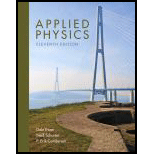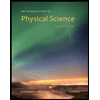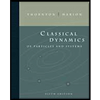
Applied Physics (11th Edition)
11th Edition
ISBN: 9780134159386
Author: Dale Ewen, Neill Schurter, Erik Gundersen
Publisher: PEARSON
expand_more
expand_more
format_list_bulleted
Concept explainers
Textbook Question
Chapter 20.2, Problem 16P
Preparing for reentry, astronauts use radar to determine the distance back to the earth. What is their altitude if it takes 0.330 s for the radar wave to travel to the earth and return?
Expert Solution & Answer
Want to see the full answer?
Check out a sample textbook solution
Students have asked these similar questions
The distance from earth to the nearest star is about 4 x 1016 meters. How long would it take a radio signal traveling at the speed of light, 3.0 x 108 m/s, to make a one-way trip to this star?
Earth is on average a distance of 2.25 x 1011 m away from Mars. If a radio signal is sent from Earth traveling at a speed of 3.0 x 108 m/s, how many seconds would it take to be received on Mars?
If the planet Mars is about 56 million kilometers from Earth, how long would it take for a radio wave sent from a space satellite circling Mars to reach Earth? Assume the radio waves (a form of electromagnetic radiation) travel at the speed of light.
Chapter 20 Solutions
Applied Physics (11th Edition)
Ch. 20.2 - Find the distance (in metres) traveled by a radio...Ch. 20.2 - Prob. 2PCh. 20.2 - A television signal is sent to a communications...Ch. 20.2 - How long does it take for a radio signal from the...Ch. 20.2 - The sun is 9.30107mi from the earth. How long does...Ch. 20.2 - A radar wave is bounced off an airplane and...Ch. 20.2 - How long does it take for a radio wave to travel...Ch. 20.2 - How long does it take for a flash of light to...Ch. 20.2 - How long does it take for a police radar beam to...Ch. 20.2 - How far away (in km) is an airplane if the radar...
Ch. 20.2 - An auto mechanic uses a strobe light to time a...Ch. 20.2 - A construction company uses GPS technology to...Ch. 20.2 - (a) How long does it take for light to reach the...Ch. 20.2 - Prob. 14PCh. 20.2 - How long does it take light to reach the earth...Ch. 20.2 - Preparing for reentry, astronauts use radar to...Ch. 20.2 - Prob. 17PCh. 20.2 - Light from the sun travels 1.50108 km to reach the...Ch. 20.3 - c=3.00108m/s =4.55105m f=?Ch. 20.3 - c=3.00108m/s =9.701010m f=?Ch. 20.3 - c=3.00108m/s f=9.701011Hz =?Ch. 20.3 - c=3.00108m/s f=24.2 MHz =?Ch. 20.3 - c=3.00108m/s f=45.6 MHz =?Ch. 20.3 - Prob. 6PCh. 20.3 - Prob. 7PCh. 20.3 - Prob. 8PCh. 20.3 - Find the wavelength of a radio wave from an AM...Ch. 20.3 - Find the wavelength of a radio wave from an FM...Ch. 20.3 - Find the frequency of an electromagnetic wave if...Ch. 20.3 - Find the frequency of an electromagnetic wave if...Ch. 20.3 - Prob. 13PCh. 20.3 - Prob. 14PCh. 20.3 - Prob. 15PCh. 20.3 - An AM radio station broadcasts a signal with a...Ch. 20.4 - Prob. 1PCh. 20.4 - Prob. 2PCh. 20.4 - Prob. 3PCh. 20.4 - Find the frequency of electromagnetic radiation...Ch. 20.4 - Find the frequency of electromagnetic radiation...Ch. 20.4 - Prob. 6PCh. 20.4 - Find the frequency of electromagnetic radiation...Ch. 20.4 - Prob. 8PCh. 20.4 - Prob. 9PCh. 20.4 - Prob. 10PCh. 20.4 - Prob. 11PCh. 20.4 - Prob. 12PCh. 20.4 - An AM radio station in a nearby town broadcasts a...Ch. 20.5 - I=48.0 cd I=___mCh. 20.5 - Prob. 2PCh. 20.5 - I=765 m I=___ cdCh. 20.5 - I=432 m I=___ cdCh. 20.5 - I=75.0 cd I=___ mCh. 20.5 - I=650 m I=___ cdCh. 20.5 - I=900 m r=7.00 ft E=?Ch. 20.5 - I=741 m r=6.50 m E=?Ch. 20.5 - I=893 m r=3.25 ft E=?Ch. 20.5 - E=4.32 lux r=9.00 m I=?Ch. 20.5 - E=10.5 ft-candles r=6.00 ft I=?Ch. 20.5 - Prob. 12PCh. 20.5 - Prob. 13PCh. 20.5 - Prob. 14PCh. 20.5 - If an observer triples her distance from a light...Ch. 20.5 - If the illuminated surface is slanted at an angle...Ch. 20.5 - Find the illumination on a surface by three light...Ch. 20.5 - Find the intensity of two identical light sources...Ch. 20.5 - Find the intensity of two identical light sources...Ch. 20.5 - A desk is 3.35 m below an 1850-m incandescent...Ch. 20 - Which of the following are examples of...Ch. 20 - Prob. 2RQCh. 20 - Prob. 3RQCh. 20 - Light behaves a. as a massive particle. b. always...Ch. 20 - Does the wavelength of light depend on its...Ch. 20 - Prob. 6RQCh. 20 - How does the intensity of illumination depend on...Ch. 20 - In your own words, explain how the speed of light...Ch. 20 - Does light always travel at the same speed?...Ch. 20 - What name is given to the entire range of waves...Ch. 20 - Prob. 11RQCh. 20 - Who developed the wave packet theory of light?Ch. 20 - Who made the first estimate of the speed of light?Ch. 20 - How was the first estimate of the speed of light...Ch. 20 - What are the units of luminous intensity?Ch. 20 - In your own words, explain luminous intensity.Ch. 20 - Find the distance (in metres) traveled by a radio...Ch. 20 - A radar wave that is bounced off an airplane...Ch. 20 - How long does it take for a police radar beam to...Ch. 20 - Prob. 4RPCh. 20 - How long does it take for a radio signal to travel...Ch. 20 - Find the wavelength of a radio wave from an AM...Ch. 20 - Find the frequency of a radio wave if its...Ch. 20 - Prob. 8RPCh. 20 - Prob. 9RPCh. 20 - Prob. 10RPCh. 20 - Prob. 11RPCh. 20 - Prob. 12RPCh. 20 - Prob. 13RPCh. 20 - Find the intensity of the light source necessary...Ch. 20 - Prob. 15RPCh. 20 - Find the intensity of two identical light sources...Ch. 20 - Find the illumination on a surface by three light...Ch. 20 - Prob. 1ACCh. 20 - (a) When the Apollo astronauts landed on the moon,...Ch. 20 - Prob. 3ACCh. 20 - The individual rods on rooftop antennas are...Ch. 20 - Prob. 5AC
Additional Science Textbook Solutions
Find more solutions based on key concepts
The setup depicted in Figure 4.6 is used in a diffraction experiment using X-rays of 0.26 nm wavelength. Constr...
Modern Physics
The electric flux through a closed surface is zero. Must the electric field he zero on that surface? If not, gi...
Essential University Physics: Volume 2 (3rd Edition)
3. What is free-fall, and why does it make you weightless? Briefly describe why astronauts are weightless in th...
The Cosmic Perspective
The pV-diagram of the Carnot cycle.
Sears And Zemansky's University Physics With Modern Physics
17. What is the tension in the rope of Figure EX7.17?
Figure EX7.17
Physics for Scientists and Engineers: A Strategic Approach, Vol. 1 (Chs 1-21) (4th Edition)
90. The photo shows Steve Hewitt and his daughter Gretchen. Is Gretchen touching her dad, or is he touching her...
Conceptual Physical Science (6th Edition)
Knowledge Booster
Learn more about
Need a deep-dive on the concept behind this application? Look no further. Learn more about this topic, physics and related others by exploring similar questions and additional content below.Similar questions
- A student drops a water-filled balloon from the roof of the tallest building in town trying to hit her roommate on the ground (who is too quick). The first student ducks back but hears the water splash 4.021 s after dropping the balloon. If the speed of sound is 331 m/s, find the height of the building, neglecting air resistance.arrow_forwardHow fast would you need to be driving towards a red light for it to appear green to you due to the doppler shift? Recall red light has a frequency of 4.6x1014 Hz and green light has a frequency of 5.5x1014 Hz. Speed: ______ m/s Convert the speed to mph using the conversion factor 1 m/s = 2.34 mph Speed: _______ mpharrow_forwardA spaceship is approaching a space station at a speed of 1.60 ✕ 105 m/s. The space station has a beacon that emits green light with a frequency of 5.94 ✕ 1014 Hz. (a) What is the frequency of the beacon observed on the spaceship? (Use c = 2.9979 ✕ 108 m/s for the speed of light. Enter your answer to at least five significant figures.)answer in Hzarrow_forward
- A spaceship is approaching a space station at a speed of 1.95 x 105 m/s. The space station emits green light with a frequency of 5.99 x 1014 Hz. Calculate is the frequency of green light observed by the spaceship. a) 6.9945 x 1014 Hz b) 5.9961 x 1014 Hz c) 5.9861 x 1014 Hz d) 5.9939 x 1014 Hzarrow_forwardA cosmic ray travels 60 km through the earth’s atmosphere in 400 μs, as measured by experimenters on the ground. How long does the journey take according to the cosmic ray?arrow_forwardAn observer at sea level does not hear an aircraft flying at 6000-m standard altitude until 15 s after it has passed over head. Estimate the aircraft speed in m/s.arrow_forward
- How long should it take the voices of astronauts on the Moon to reach the Earth? Assume that the only significant time is the transit time from the Earth to the Moon, at the speed of light. Suppose that the astronaut on the surface of the Moon, the receiver on the surface of the Earth, and the centers of the Earth and the Moon are aligned. The distance between the centers of the Earth and the Moon is 384×103km, the radius of the Earth is 6.38×103km, the radius of the Moon is 1.74×103km.arrow_forwardApproximately how long would it take a telephone signal to Travel 480 km ( 1km= 1000m) from earth to the international space station? ( telephone signals travel at the speed of light).arrow_forwardYou encounter a moving walkway that is 75 mm long and has a speed of 1.9 m/sm/s relative to the ground.How long would it take you to cover the 75 mm length of the walkway if, once you get on the walkway, you turn around and start walking in the opposite direction with a speed of 1.4m/s relative to the walkway?arrow_forward
- 10: An airplane flew from Manila( 121o30' E, 14o N ) on a course of S 30o W and maintaining a uniform altitude. At what longitude will the plane crosses the equator? Select one: a. 113o 33' E b. 110o 28' E c. 114o 41' E d. 112o 38' Earrow_forwardAn out-of-control alien spacecraft is diving into a star at a speed of 1.0 x 108 m/s. At what speed, relative to the spacecraft, is the starlight approaching?arrow_forward2. The speed of light in a vacuum is c = 3 × 10 8 m / s, and the distance from the Earth to the Sun is R ≈ 150 × 10 6 km . a. A light-minute is the distance that light travels in 1 minute. What is a light minute in meters? b. Express the Earth-Sun distance R in terms of light-minutes. c. How much time does it take for light to travel from the Sun to the Earth? 3. (1.39) Tectonic plates are large segments of Earth's crust that move slowly. Suppose a plate has average speed of v = 4.0 cm / year . a. What distance does the plate move in 1.0 s? b. Express the speed v in km/million year .arrow_forward
arrow_back_ios
SEE MORE QUESTIONS
arrow_forward_ios
Recommended textbooks for you
 An Introduction to Physical SciencePhysicsISBN:9781305079137Author:James Shipman, Jerry D. Wilson, Charles A. Higgins, Omar TorresPublisher:Cengage Learning
An Introduction to Physical SciencePhysicsISBN:9781305079137Author:James Shipman, Jerry D. Wilson, Charles A. Higgins, Omar TorresPublisher:Cengage Learning Classical Dynamics of Particles and SystemsPhysicsISBN:9780534408961Author:Stephen T. Thornton, Jerry B. MarionPublisher:Cengage Learning
Classical Dynamics of Particles and SystemsPhysicsISBN:9780534408961Author:Stephen T. Thornton, Jerry B. MarionPublisher:Cengage Learning

An Introduction to Physical Science
Physics
ISBN:9781305079137
Author:James Shipman, Jerry D. Wilson, Charles A. Higgins, Omar Torres
Publisher:Cengage Learning

Classical Dynamics of Particles and Systems
Physics
ISBN:9780534408961
Author:Stephen T. Thornton, Jerry B. Marion
Publisher:Cengage Learning
Position/Velocity/Acceleration Part 1: Definitions; Author: Professor Dave explains;https://www.youtube.com/watch?v=4dCrkp8qgLU;License: Standard YouTube License, CC-BY